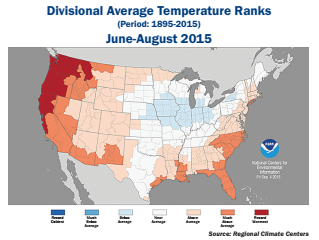B. Pollination and Grain Fill Conditions – Summer (June – August)
Record wet June, cool summer favored starch accumulation

Corn pollination typically occurs in July, and at pollination time, greater than average temperatures or lack of rain typically reduce the number of kernels. The weather conditions during the grain-filling period in July and August are critical to determining final grain composition. During this time, moderate rainfall and cooler than average temperatures, especially overnight temperatures, promote starch and oil accumulation and high yields. Moderate rainfall and warm temperatures in the second half of grain-fill (August to September) also aid continued nitrogen uptake and photosynthesis. Nitrogen also remobilizes from the leaves to the grain during late grain-filling, leading to increases in grain protein and hard endosperm.

The overall early planting in 2015 created an opportunity for the plants to take advantage of the long June days for optimal growth. However, abundant June rainfall throughout the corn-growing regions flooded fields. This excessive moisture removed some of the nitrogen fertilizer from the soil before the plants could accumulate the nitrogen, thereby reducing the potential final grain protein concentration and horneous endosperm. Additionally, the low
corn prices and expected low return on investment discouraged producers from generous pre-plant and sidedress fertilizer applications, likely leading to lower grain protein accumulation. However, many producers were able to apply some fertilizer after the June rain to maximize yield potential. The rain in June further helped to minimize the long-term drought conditions in the Southern Rail ECA, and provided abundant subsurface water for grain development.
As the summer progressed, areas in all three ECAs changed from a very wet early growth period to a dry grainfilling period. Pollination occurred during this transition, and those fields pollinating in rainy weather were more susceptible to Fusarium infection. Average temperatures were normal to below-normal, and usual day-night temperature swings were moderated in all three ECAs. These conditions produced warm nights and days with minimal heat stress, promoting starch accumulation and larger kernels. While a large section of the Gulf ECA was cool in August, the Pacific Northwest ECA experienced average-to-warm temperatures, allowing an extended grainfilling period, resulting in grain with closer to long-term average protein, starch, and oil concentrations.
